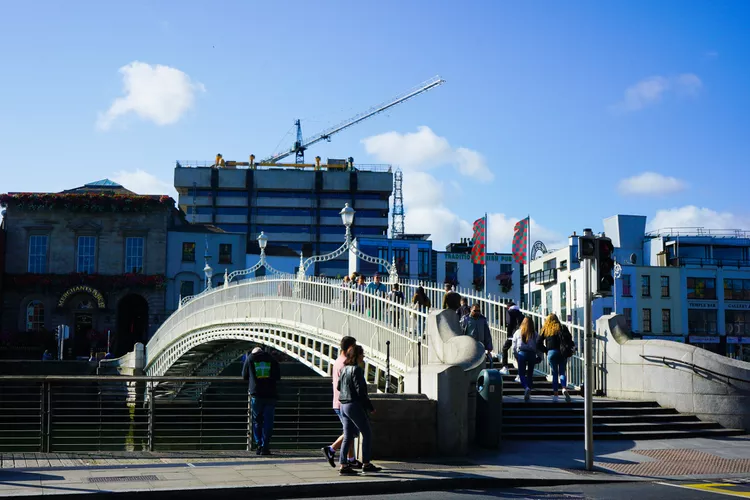Exploring Dublin: A Scenic River Walk
“Flow Liffey Waters, Flow Gently to the Sea …”
If you want to take a walk through Dublin, walking along the river Liffey is the easiest choice. Dublin’s most logical walk simply follows nature’s course – a stroll along the banks of the legendary Liffey, the river that cuts the Irish capital in two, divides the Northside from the Southside. Although you will not encounter many of Dublin’s main attractions, this walk is one of the unique experiences Ireland’s capital city offers. Follow the course of the River Liffey through the city, from the revived Dublin Docklands to the expansive Phoenix Park.
Starting in the Docklands
The most logical place to start this walk is in the Docklands, a once run-down area that has been undergoing extensive renovations. Head for the offices of the Dublin Docklands Development Authority (DDDA) between the International Financial Services Centre (IFSC) and Jurys Hotel. Then step onto the pedestrian bridge, officially the Sean O’Casey Bridge, and take a good look around. To the east, you can see the harbor and the new Samuel Beckett Bridge, shaped like a harp. Nearby, the tall ship “Jeanny Johnston” is usually berthed.
South of the bridge is a memorial to merchant mariners killed during the “Emergency” from 1939 to 1945. Nearby you will also find “The Linesman”, a life-like bronze of a worker.
Turn westwards to come to a modern road bridge—the Matt Talbot Memorial Bridge—featuring an impressive statue of the venerated Dublin mystic near its southern end. From here, enjoy the panorama of Customs House to your left and the modern IFSC straight across the Liffey. Cross the bridge and take a look at the haunting Famine Group just to the right, before continuing westwards, passing Customs House. Additionally, don’t overlook the modern structure housing the Ulster Bank—photographers will cherish the reflection of Customs House in its façade.
Proceed underneath Dublin’s greatest eyesore, the dark railway bridge, passing Butt Bridge, and continue upstream along the river. The tall hulk on your right is Liberty Hall, Dublin’s tallest building and the trade union HQ. A statue of Irish-American socialist James Connolly stands opposite Liberty Hall underneath the elevated railway. Observe the remnants of Dublin’s maritime past on the buildings lining the Liffey.

The Heart of Dublin City
You are now approaching O’Connell Bridge with O’Connell Street to your right. This is the center of Dublin and a rather curious bridge—it is actually wider than long. Take a good look around and then continue on Bachelor’s Walk, aiming for the Ha’penny Bridge.
Formally known as the “Liffey Bridge” or “Wellington Bridge”, the bridge earned the nickname Ha’penny Bridge due to an old toll for pedestrians. Cross the Liffey (it is free today); the small lane opposite would lead you into the Temple Bar District. Instead, turn right and walk to the new Millennium Bridge, re-crossing the river. Once again, stop in the middle, take in the view, and then proceed upstream.
Viking Dublin
Before reaching Grattan Bridge, look across the Liffey at the embankment. You should spot a grated tunnel entrance—this is the outlet of the River Poddle, which formed a “dark pool” (or in Irish dubh linn) nearby. Here, the Vikings established a settlement. After crossing Grattan Bridge, you can see the entrance to Dublin Castle just visible at the end of Parliament Street. Also visible are the Sunlight Chambers, a magnificent corner building adorned with lavish artwork celebrating cleanliness and soap!
Following the Liffey upstream, you’ll notice a curious collection of park benches on the left, recreating the image of a sinking Viking longboat. Further on, the prow of a Viking boat inspired the monument outside the (modern) council offices. As you walk, pay attention to bronze inlets in the pavement—replicas of Viking artifacts discovered nearby a few years ago. You are in the heart of Viking Dublin!
When you reach O’Donovan Rossa Bridge, take in the views from here: to the south, Christ Church Cathedral crowns the rise, and to the north, the Four Courts line the Liffey. Remain on the river’s southern bank to enjoy the best views of the court buildings.
Dublin’s Favourite Drinks
The next bridge is Father Matthew Bridge—a fitting memorial to the founder of the temperance movement due to its location.
On the northern side, you will notice a tall chimney-like structure, which is the old chimney of the Jameson Distillery. Not far off is the Guinness Brewery. You will pass it as you continue up the Liffey, moving past Mellowes Bridge, Blackhall Place Bridge, and Rory O’More Bridge, until you finally arrive at Frank Sherwin Bridge and nearby Sean Heuston Bridge. If the wind is right, you may catch a delightful whiff of malt.
Journey’s End – Back to Dublin City
Take a moment to admire the magnificent façade of Heuston Station, then cross over to the northern quays and walk downstream, passing the Civil Defence Depot on your left. The park next to it, the “Croppy Acre”, serves as a mass grave for those killed in the 1798 rising. After this, take a left and walk up to Collins Barracks – the National Museum of Ireland.
Even if you are not particularly interested in culture, the café will provide a welcome sight. After refreshing your energy, you can easily catch a LUAS tram back to the city center.
However, should you feel highly energetic again, a short walk west will take you to either the Phoenix Park, Dublin Zoo, or the often-overlooked War Memorial in Island Gardens.





